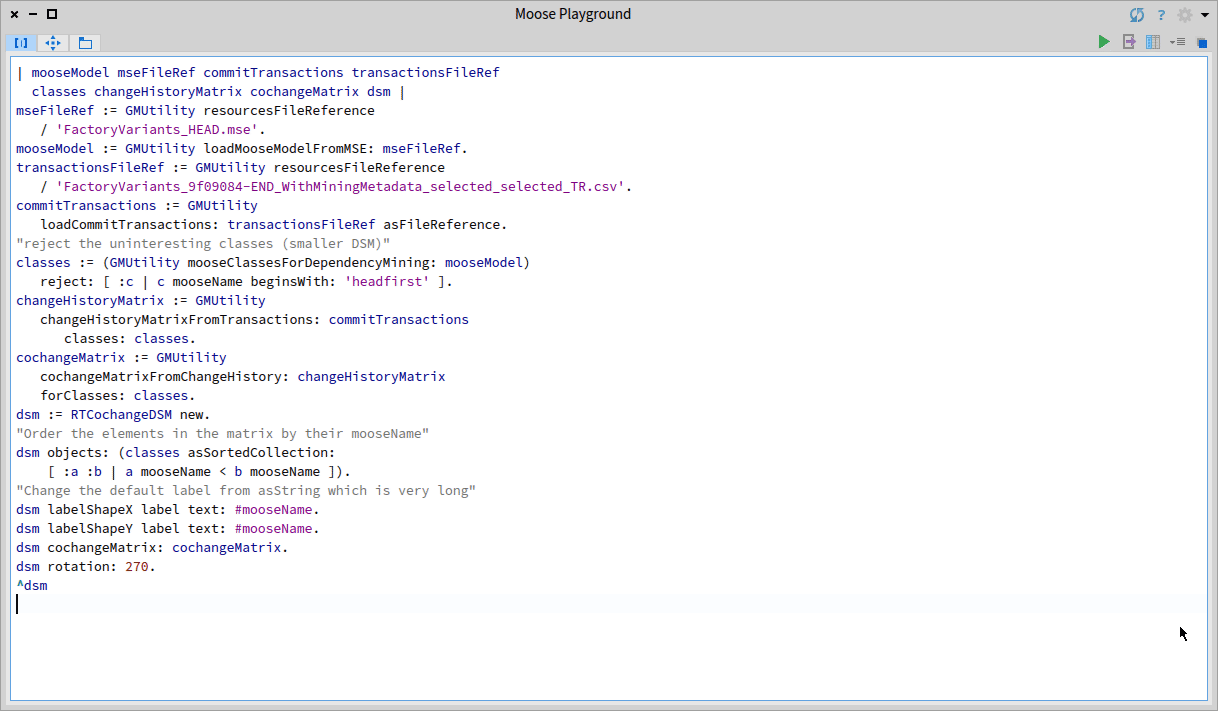Using a DSM to visualize co-change of Java classes
In a previous post, I explained how to do a DSM from a Java project in Moose. In this post, I will extend the idea to a DSM-based visualization for co-change, again with a Java project using Moose.
Background
Simply defined, co-change is the notion that two modules in a project change together. We can identify co-change in a project when multiple modules are committed to a repository together.
A Design Structure Matrix (DSM) can be used to visualize co-change in a project, e.g., see Geipel and Schweitzer (2012). That is, a cell x,y in the matrix contains the number of times the file x and y were changed in the same commit.
Sample co-change data mined from git
Co-change information can easily be extracted from a git repo’s history. The following comma-separated file was generated from a git repo using features of the GitMiner project (but we leave the details for another day). For now, let’s look at how the file is formatted:
9a300b2,src/ClientNoFactoryMain.java,src/no_factory/ProductA.java
7c6d160,src/simple_factory/ProductA.java,src/simple_factory/SimpleFactory.java
544262f,src/no_factory/ProductA.java
908c96e,src/ClientNoFactoryMain.java,src/no_factory/ProductA.java
9f09084,src/ClientWithUnprotected.java,src/NoInterfaceClient.javaThe format is commitID , file1.java , file2.java , … where a commit can have any number of java files.
Note, this is not really a consistent CSV format, since the number of columns can vary at each line.
We can see that at commit 9a300b2 the files src/ClientNoFactoryMain.java and src/no_factory/ProductA.java were committed together, meaning there was a co-change link. We can also see that those two files were also implicated in the same commit 908c96e.
Commit 544262f only had a single file committed, so there is no co-change there.
Visualizing co-change in a DSM
For this visualization, in the GitMiner project there’s a Pharo class called GMCochangeMatrix, which serves as a model for the visualization class, RTCochangeDSM, which is a subclass of RTAbstractDSM. It redefines some methods in the visualization to work with the GMCochangeMatrix model.
My design here is surely not optimal; there is likely a better way to make this work, but I was interested in getting results for my research. Constructive comments are welcome at the bottom of this post.
For the following code to work, you first have to load the GitMiner project in Pharo 7, following the instructions on the repo’s page. Once it’s loaded, you can open a Moose Playground and paste the following code that uses the sample co-change data and FAMIX model for the FactoryVariants project in Java:
| mooseModel mseFileRef commitTransactions transactionsFileRef
classes changeHistoryMatrix cochangeMatrix dsm |
mseFileRef := GMUtility resourcesFileReference
/ 'FactoryVariants_HEAD.mse'.
mooseModel := GMUtility loadMooseModelFromMSE: mseFileRef.
transactionsFileRef := GMUtility resourcesFileReference
/ 'FactoryVariants_9f09084-END_WithMiningMetadata_selected_selected_TR.csv'.
commitTransactions := GMUtility
loadCommitTransactions: transactionsFileRef asFileReference.
"reject the uninteresting classes (smaller DSM)"
classes := (GMUtility mooseClassesForDependencyMining: mooseModel)
reject: [ :c | c mooseName beginsWith: 'headfirst' ].
changeHistoryMatrix := GMUtility
changeHistoryMatrixFromTransactions: commitTransactions
classes: classes.
cochangeMatrix := GMUtility
cochangeMatrixFromChangeHistory: changeHistoryMatrix
forClasses: classes.
dsm := RTCochangeDSM new.
"Order the elements in the matrix by their mooseName"
dsm objects: (classes asSortedCollection:
[ :a :b | a mooseName < b mooseName ]).
"Change the default label from asString which is very long"
dsm labelShapeX label text: #mooseName.
dsm labelShapeY label text: #mooseName.
dsm cochangeMatrix: cochangeMatrix.
dsm rotation: 270.
^dsmHere’s the visualization in action, when you Do it all and go:

The GMCochangeMatrix has the following properties with respect to the cells on its diagonal (Geipel and Schweitzer 2012):
- The cell m,m contains the total number of times class m was changed.
- The sum of the diagonal is the total number of changes.
In Pharo, you can send the message GMCochangeMatrix>>#cochangeMatrix to obtain a PMMatrix (part of PolyMath) and then get its principalDiagonal. Converting the diagonal to an Array allows you to get its sum. To demonstrate the above properties, insert the following before the ^dsm line in the example above:
Transcript show: 'Diagonal: '
, cochangeMatrix cochangeMatrix principalDiagonal asString; cr.
Transcript show: 'Total changes: ',
(cochangeMatrix cochangeMatrix principalDiagonal asArray sum)
asString.On the Pharo transcript, you should see:
Diagonal: a PMVector(2 0 1 1 3 0 0 0 1 0 0 1 0 0 0 0)
Total changes: 9